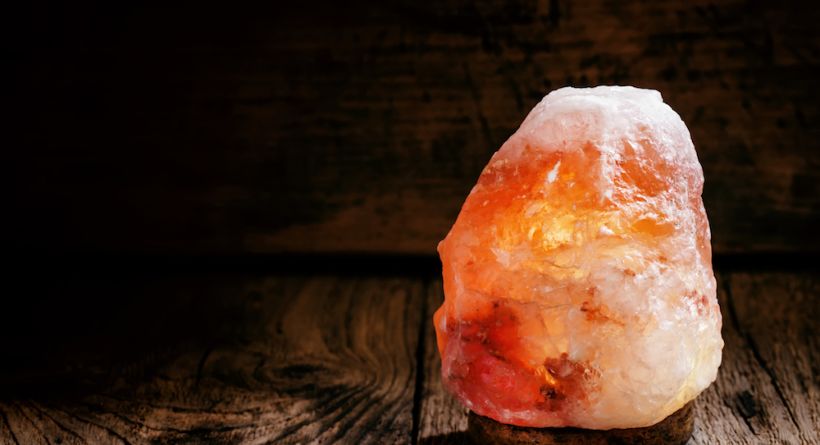Salt lamps have become a popular home decor item, admired for their warm glow and the claimed health benefits they provide.
These unique lamps, made from large chunks of Himalayan salt, are said to improve air quality, create a calming ambiance, and even help with allergies.
However, a common issue faced by many salt lamp owners is melting or sweating. You might find yourself asking, “Why is my salt lamp melting?”
The answer lies in the natural properties of salt and how it interacts with its environment.
This article will explore the reasons behind salt lamp melting, offer practical tips to prevent it, and explain why it’s crucial to care for your salt lamp properly.
What Is Salt Lamp Melting?
If you’ve noticed your salt lamp sweating or leaving small puddles of water underneath, you’re witnessing a common phenomenon caused by the lamp’s hygroscopic nature.
Salt, as a material, absorbs moisture from the air. When your salt lamp is exposed to high humidity or moist environments, it can pull water out of the surrounding air. This process can make it seem like your lamp is melting, but in reality, it’s just absorbing water.
The Science Behind Salt Lamp Melting
The melting of salt lamps is scientifically explained by a process called hygroscopy. Hygroscopic substances, like salt, have the ability to absorb water molecules from their surroundings.
Salt is particularly effective at pulling moisture out of the air. When the air around your salt lamp is humid, the salt absorbs the moisture, which can lead to a “weeping” effect, where droplets of water form on the surface of the lamp and drip down.
This phenomenon is most noticeable in areas with high humidity or during rainy seasons.
If your salt lamp appears to be melting or sweating, it’s simply a result of it absorbing too much moisture from the air.
This isn’t a defect in the lamp, but rather a natural property of the salt.
Also Read: How to Get Rid of the Pii Errors [pii_email_e188285bdb71eb7570eb] Error?
How Humidity Affects Your Salt Lamp
Humidity is the main factor behind salt lamp melting. If you live in a humid climate, your salt lamp is more likely to sweat.
Even normal household activities like boiling water, showering, or using a dishwasher can increase the humidity levels in your home and contribute to your salt lamp melting.
Practical Tip: Keep Your Lamp in a Dry Area
One of the best ways to prevent your salt lamp from melting is to place it in a dry environment.
Avoid areas with high moisture levels such as bathrooms, kitchens, or laundry rooms. Ideally, your salt lamp should be kept in a room with lower humidity, like a bedroom or living room.
Preventing Salt Lamp Melting: Practical Solutions
If you’re experiencing issues with your salt lamp melting, don’t worry—there are several simple solutions to prevent this from happening.
Here are some practical steps you can take to protect your lamp:
Use a Dehumidifier
Since humidity is the primary cause of salt lamp melting, reducing the humidity in your home is an effective way to prevent this issue.
You can use a dehumidifier to lower moisture levels in the air. This is especially useful if you live in a humid climate or if you notice that your salt lamp tends to sweat during certain seasons.
Wipe Down Your Lamp Regularly
Make it a habit to check your salt lamp for excess moisture. If you notice water collecting on the surface, gently wipe it down with a soft, dry cloth.
Regular cleaning will help prevent the accumulation of moisture and reduce the chance of your lamp melting.
You don’t need to do this every day—just when you notice the lamp starting to sweat.
Keep the Lamp On
Interestingly, leaving your salt lamp on can help prevent melting. The heat generated by the lamp helps to evaporate any moisture that the salt absorbs.
Many people find that keeping their lamp on continuously minimizes sweating and extends the life of the lamp.
If you prefer not to leave it on all the time, try using a low-wattage bulb to keep it warm without consuming too much electricity.
Taking Care of Your Salt Lamp
In addition to controlling humidity, there are a few other ways you can take care of your salt lamp to prevent melting and ensure it lasts for a long time.
Use the Right Bulb
The bulb inside your salt lamp plays a crucial role in keeping it dry. A heat-producing bulb helps evaporate moisture, preventing your lamp from sweating.
The appropriate wattage depends on the size of your lamp:
- For lamps weighing up to 10 pounds, a 15-watt bulb is sufficient.
- For lamps between 10 to 20 pounds, use a 25-watt bulb.
- For larger lamps over 20 pounds, opt for a 40 to 60-watt bulb.
Using the wrong bulb could result in your lamp not getting warm enough to evaporate moisture, leading to dripping or sweating.
Monitor the Bulb for Issues
If your salt lamp continues to sweat even with the correct bulb, check the condition of the bulb itself.
Moisture from the salt can sometimes leak into the bulb and cause it to flicker or malfunction. If this happens, replace the bulb and ensure it’s securely in place.
Place a Protective Layer Underneath
In cases where your lamp continues to drip despite your best efforts, it’s wise to place a protective layer underneath it.
A coaster, plastic mat, or small tray can catch any moisture and prevent it from damaging your furniture.
Also Read: Buying a Tranny Tube: A Comprehensive Guide
Real-Life Examples of Salt Lamp Care
One example of effective salt lamp care comes from Sarah, a resident of Florida, where the humidity is high year-round.
Sarah noticed that her salt lamp started melting a few days after she brought it home.
After researching, she moved the lamp to her air-conditioned bedroom and started using a dehumidifier.
She also switched to a higher-wattage bulb, which helped keep the lamp warm enough to evaporate the moisture.
Since then, her lamp has stayed dry, and she hasn’t experienced any issues with melting.
Common Misconceptions About Salt Lamp Melting
There are several misconceptions about why salt lamps melt. Some people assume that if their salt lamp starts sweating, it’s defective.
However, this is rarely the case. Salt lamps melt due to their natural ability to absorb moisture from the air, not because they are damaged.
Understanding this fact can help you care for your lamp properly and avoid unnecessary replacements.
The Environmental Impact of Salt Usage
While salt’s hygroscopic nature can be an issue for salt lamps, it also raises larger environmental concerns, particularly when it comes to the widespread use of road salt in winter.
Road salt, which is used to melt ice on streets, can have devastating effects on the environment:
- Water Pollution: When road salt dissolves, it can enter local waterways, increasing salinity levels and harming aquatic life.
- Soil Damage: Salt can dehydrate the soil, making it difficult for plants to grow.
- Infrastructure Damage: Salt accelerates the corrosion of roads, bridges, and vehicles, leading to costly repairs.
Because of these impacts, more people are seeking safer alternatives for ice melting.
Safer Alternatives to Road Salt
If you’re concerned about the environmental impact of salt, consider using products like Safe Paw, a pet-friendly and eco-friendly alternative to traditional road salt.
Safe Paw is free from harsh chemicals, making it safe for pets, children, and the environment.
Unlike traditional salt, it won’t corrode concrete or damage your property.
Final Thoughts
Salt lamps are a beautiful and beneficial addition to any home, but they require some care to prevent melting.
By understanding the science behind salt lamp melting and following practical steps to control humidity, you can enjoy your lamp for years to come.
Remember to use the right bulb, keep the lamp in a dry area, and regularly wipe it down.
Taking these small steps will help protect your salt lamp and ensure it continues to provide a warm, calming glow.
Salt is a powerful substance that interacts with its environment in fascinating ways.
Whether you’re managing a salt lamp at home or considering alternatives to road salt, being informed about its properties and effects can help you make smarter, more sustainable choices.


